Lettuce aquaponics is the way to go if you are struggling to start a home garden. Lettuce is super low maintenance, grows extremely fast, and has vitamins A and K.
Using it in an aquaponic system encourages maximum growth. Though initially, you might find it tricky. You’re in luck! Get ready to eat salads, sandwiches, and wraps made with greens grown by yourself.
In this article, you will learn the correct way to grow each variety of lettuce in aquaponics, how to keep the pests away, the ideal temperature, ph level, and nutrients needed for it to grow healthily. Allow us to commence!
Contents
Benefits of Growing Lettuce in Aquaponics
Hydroponics refers to growing plants in nutrient-rich water. Aquaculture means raising aquatic animals in a tank. A food-growing system is developed by combining these two, namely Aquaponics.
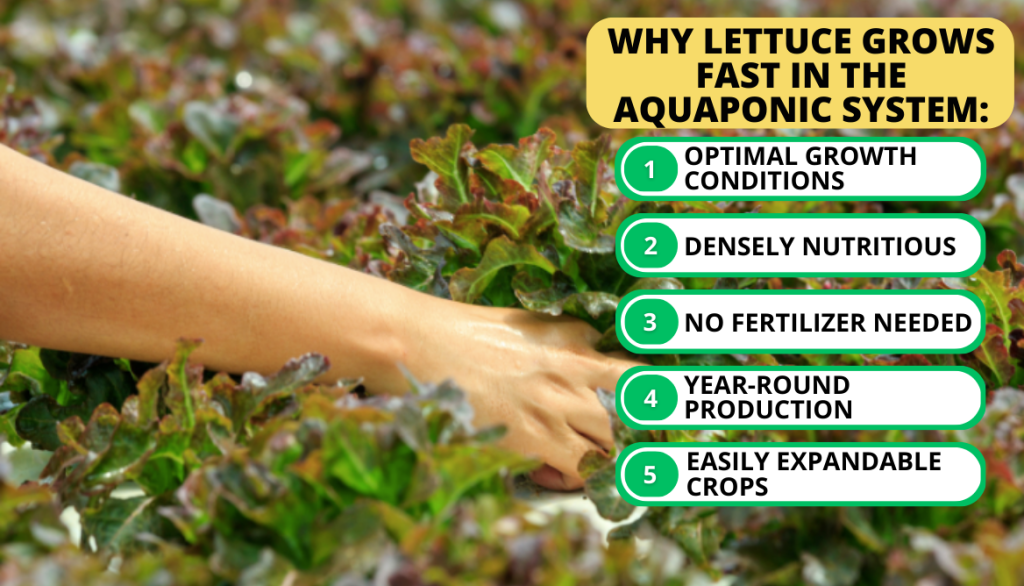
The aquaponic system benefits both plants and fish. The plants assist in filtering and cleansing the fish’s water while the fish waste supplies nutrients for them. Lettuce grows incredibly in it. Here is why:
- Optimal Growth Conditions: Regulated temperature, pH, and nutrient levels, in aquaponics systems, resulting in increased volumes of lettuce than traditional growing methods.
- Densely Nutritious: As the water in aquaponics systems is rich in nutrients, the lettuce turns out extremely healthy. It also ensures a faster growth rate.
- No Fertilizer Needed: Fish waste provides a natural fertilizer. Hence no need for fertilizers or chemicals that could be harmful. You will have organic lettuce plants grow.
- Year-Round Production: Aquaponic lettuce can be harvested throughout the year. Meaning you get more out of one plant and access fresh produce from home.
- Easily Expandable Crops: Lettuce can be multiplied with little effort in an aquaponic system. Clone it by taking cutting from a grown plant and placing it in the water. It will grow roots within days and mature quickly.
Aquaponic Lettuce: Learn its Growing Requirements and Facts
To grow lettuce like a pro and efficiently, we need to be well-versed in the ideal conditions it thrives in:
Hydroponic pH: | 5.5 to 6.0 |
Temperature: | 70 to 74°F (21-23°C) |
Plant Spacing: | 7 to 12 inches apart |
Adult Plant Height: | 8 to 12 inch |
Power Source: | Adult Plant Width: 10 to 14 inch |
Germination: | 3 to 7 days (in temperatures 55 to 70°F or 13-21°C) |
Harvest Time: | 24 to 32 days (with the exception of a few varieties) |
Light Exposure: | Direct sunlight but slight shading if the temperature is warm |
Recommended Aquaponic System: | Deep Water Culture, Nutrient Film Technique, Media Bed |
We need to study the following facts to get the best results.
- Lettuce is a valuable and high-demand vegetable.
- It is a winter crop making it an excellent option for aquaponic systems.
- Lettuce has a low nutrient requirement.
- Lettuce grows best in temperatures, ranging between 37°F and 54°F at night, whilst 63°F and 82°F during the day.
- Water temperatures above 79°F can cause lettuce to become bitter.
- Summer-grown lettuce crops prefer higher calcium concentrations to stop tip burn.
Growing Lettuce in Aquaponics: Simple Steps to Start
We are now aware of the optimal conditions the lettuce requires. Let’s move towards growing lettuce in aquaponics. It is a sustainable and easy way of growing plants to produce fresh, nutrient-rich greens year-round. Perform the steps below to start the crops in your garden.
Step 1: Start Lettuce Seeds Germination
Starting lettuce seeds or germination takes from 3 to 7 days. There are multiple ways you can do that. You can:
- Purchase a ready-to-use starter medium kit from Amazon. Here are a few recommendations:
- Build your germination kit.
- Use a paper towel for germinating seedlings.
The following are considered the best starting mediums for aquaponic lettuce:
- Rockwool Cubes: These are made from volcanic rock that has been heated and spun into fibers.
- Coco Coir Pellets: It is a natural fiber made from coconut husks.
- Peat Pellets: They are made up of compressed peat moss and are great for moisture retention.
- Perlite: It is a lightweight, volcanic glass. Useful for good aeration and drainage.
- Water: Place seeds in a container filled with water. Carefully monitor and do not let them drown.

Step 2: Time to Transplant the Seedlings
After your lettuce seedlings have reached around three weeks of age and possess 2 to 3 true leaves, they can be transplanted into your aquaponic lettuce system.
However, for the best results, we recommend supplementing the seedlings with a bit more phosphorous in the second or third week. This added nutrient will boost root growth and strengthen the plants, reducing stress.
Use our handy pro-tip mentioned below.
If you are growing lettuce outside, gradually familiarize the seedlings with typical growing conditions 3 to 5 days before transplantation. This includes colder temperatures and direct sunlight. This will help seedlings adapt to the environment.
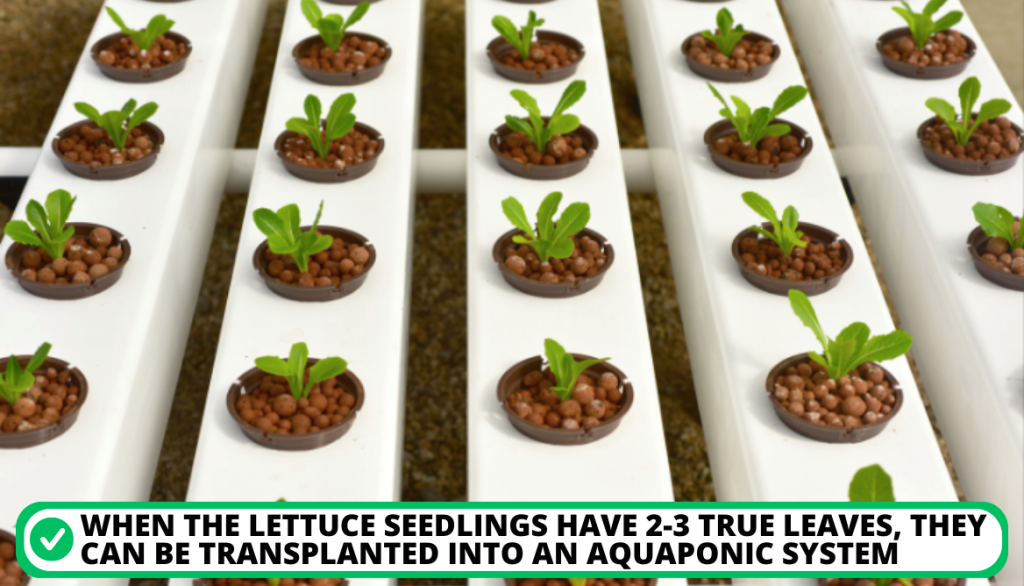
Step 3: Keep Up with Its Maintenance till Maturity
Unlike some other plants maintenance for aquaponics lettuce is not difficult. There are a few things to remember and monitor. Note them down
- Aeration: The roots should have access to an oxygen supply and be properly aerated.
- Light: The plants should have a sufficient amount of it. A minimum of 8 hours and up to 16 hours is enough light.
- Nutrients: Add fish feed and other nutrients to the water. Keep the nitrogen level as close to zero. Monitor the amount fish consume as the food and the waste contains nitrite and nitrate.
- Pruning: Timely harvest of the crop to encourage maximum growth and continuously growing lettuce.
- Water Temperatures: Check for the correct water temperature which is around 70℉ to 74℉. Consider the fish species in your system as okra and tilapia like warmer climates.
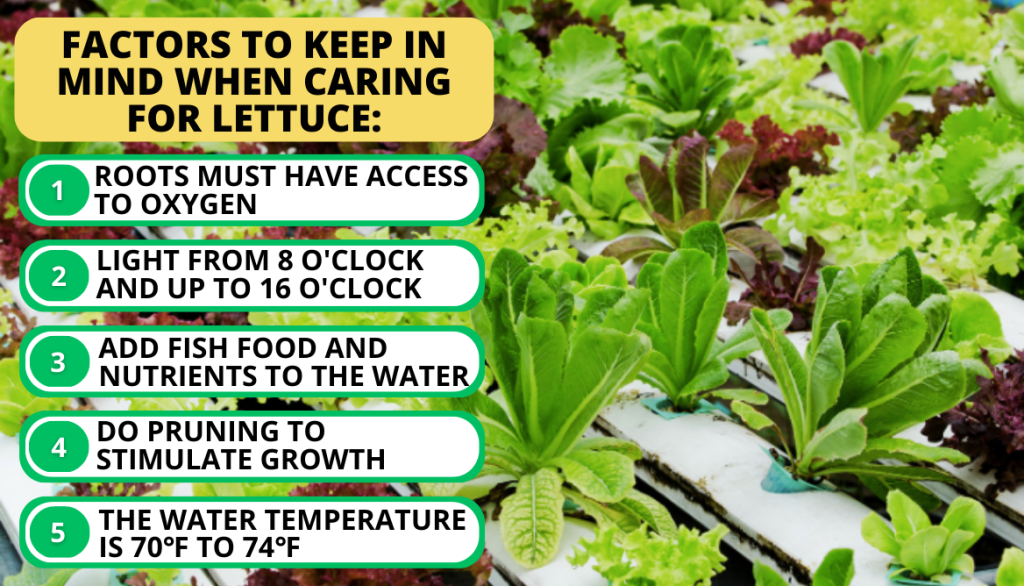
Step 4: Harvest the Grown Aquaponic Lettuce
Depending 0n the type of aquaponics lettuce there are two types of cuttings you should do. Let’s view what varieties suit which type of cutting.
Loose leaf lettuce and Romaine lettuce
Once the plant has attained an adequate size for consumption, though it does not have to attain full maturity, the outer leaves may be cut. The harvested leaf will be replaced with young ones.
Iceberg and Bib (even Romaine)
If the lettuce has matured and grown you can cut it from the base of the plant. Harvest the entire head and enjoy.

In-Depth View on Conditions for Lettuce Aquaponic
Above we did a quick preview of the required conditions for lettuce plants. Let’s now go in-depth and learn why should we take care of each factor so seriously. Do watch this video for help with growing plants of this nature.
1. Water Temperature
Lettuce is known to flourish in water temperatures ranging from 70 to 74°F (21-23°C). This optimal temperature range for lettuce growth also coincides with that suitable for many fish, making lettuce a suitable crop for most aquaponics systems.
2. Air
Proper airflow within the growing environment is critical to increasing transpiration and nutrient uptake. It increases the amount of dissolved oxygen. Aeration also helps to circulate the water in the system, which prevents the buildup of harmful substances.
3. Ph Levels
Maintaining a pH level between 5.5 to 6.0 is ideal for growing lettuce in aquaponics. It can still survive outside this range, though it may not develop to its full potential in terms of size and taste.
It is advisable to maintain higher calcium concentrations in the water to prevent tip burn on lettuce leaves during summer.
4. Plant Spacing
For maximum yield, it is recommended to plant one lettuce every seven inches. It will give adequate space without competition for nutrients or blockage of light. This spacing may vary depending on the type of lettuce, as rocket lettuce requires less space than butterhead lettuce.
5. Get Rid of Pests
Aquaponics systems have fewer pests than traditional gardening systems due to the absence of soil. However, it is important to be cautious when using pest control measures for lettuce in aquaponics gardens, because you will eventually consume the produce.
It is better to avoid pesticides due to these being harmful to the fish and consumers. Instead uses other methods such as:
- Beneficial insects or predator bugs such as ladybugs can be introduced to control pests without harming the lettuce.
- Physically remove visible pests.
- Interspersing lettuce with pest-repelling plants like chives or mint can help keep pests away.
- Placing a bug net over the plants.
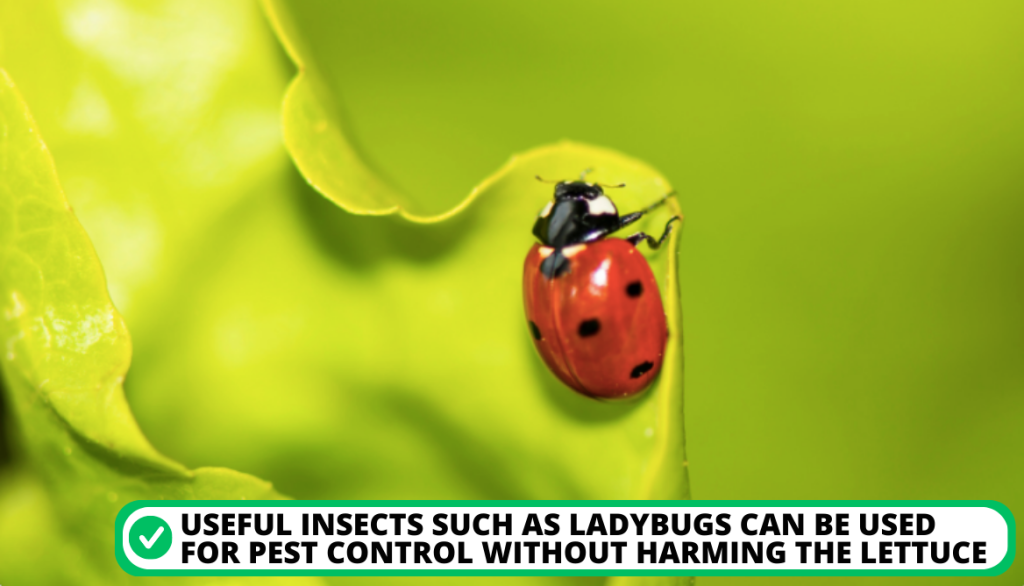
Pros and Cons to Know: Is Lettuce Good for Aquaponics?
Lettuce is considered one of the best crops to grow in an aquaponics system. Let’s weigh its pros and cons to judge better.
- Lettuce is not sensitive to slight fluctuations in water temperature. 70℉ – 74℉ is the range it performs best in an aquaponics system.
- It is a low-maintenance crop and is one of the easiest to grow in an aquaponic system.
- Lettuce is one of the fastest-growing vegetables and twice the speed in aquaponics.
- Aquaponic systems have fewer pest problems compared to soil-based growing. Lettuce grown in these is safe to consume.
- It is more nutritious than lettuce grown conventionally and tastes sweet.
- It needs to be replanted frequently as it grows fast.
- Larger setups can have high costs. You need to purchase equipment for both aquaculture and hydroponics.
How Long Lettuce Varieties Take to Grow
Lettuce grows quite quickly, and in aquaponics gardens, it speeds up even more. Although the different types have variations in the time they take to grow. The denser lettuce takes up to 45 to 60 days while leafy ones mature in 30 days. Let’s view the list.
Fastest Lettuce Variety
Lettuces that are ready to consume in a month are:
- Coastline summer crisp lettuce
- Flashy butter oak lettuce
- Ithaca iceberg lettuce
- New red fire loose-leaf lettuce
- Ice green loose-leaf lettuce
- Lau’s pointed-leaf romaine lettuce
- Summer bibb butterhead lettuce
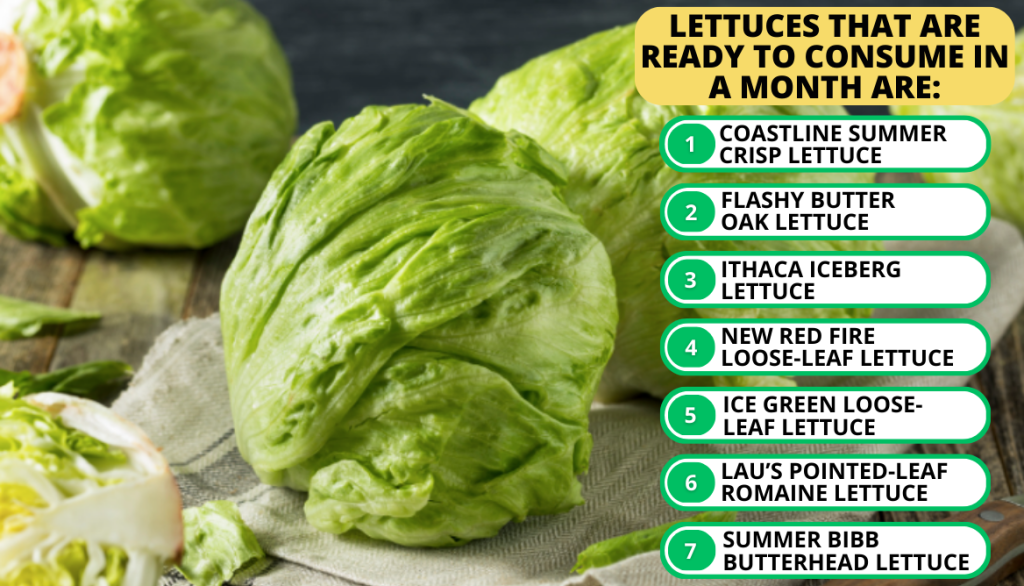
Slower Lettuce Variety
Lettuce that can take more than a month to mature is the following along with the time it takes:
- Corn salad mache lettuce: 50 days
- Parris Island romaine variety: 50 days
- Tennis ball bibb lettuce: 55 days
- Tom Thumb butterhead lettuce: 55 days
- Frisee endive lettuce: 65 days
- Celtuce lettuce: 75 days

Qualities of Aquaponics Lettuce Varieties
You can effortlessly grow all the 15 varieties mentioned above in an aquaponics garden. However, let’s have a look at the qualities of the most popular types. Here we go.
Iceberg (crisphead) Lettuce
A round, cabbage-like type of lettuce. It has a tight, compact head of leaves that are pale green on the outside and white on the inside. It’s low in calories and high in water content. Let’s see what else:
- Taste: Mild and sweet taste.
- Texture: Crispy and crunchy
- Nutrients: Vitamin K and Potassium
- Climate: Better in cooler climates
- Harvesting: Cut from the head of lettuce
- Aquaponic System: Best for Deep Water Culture or Media Bed (Can grow in others)
- Difficulty: Easy to grow. Can be difficult to get the head formation right.
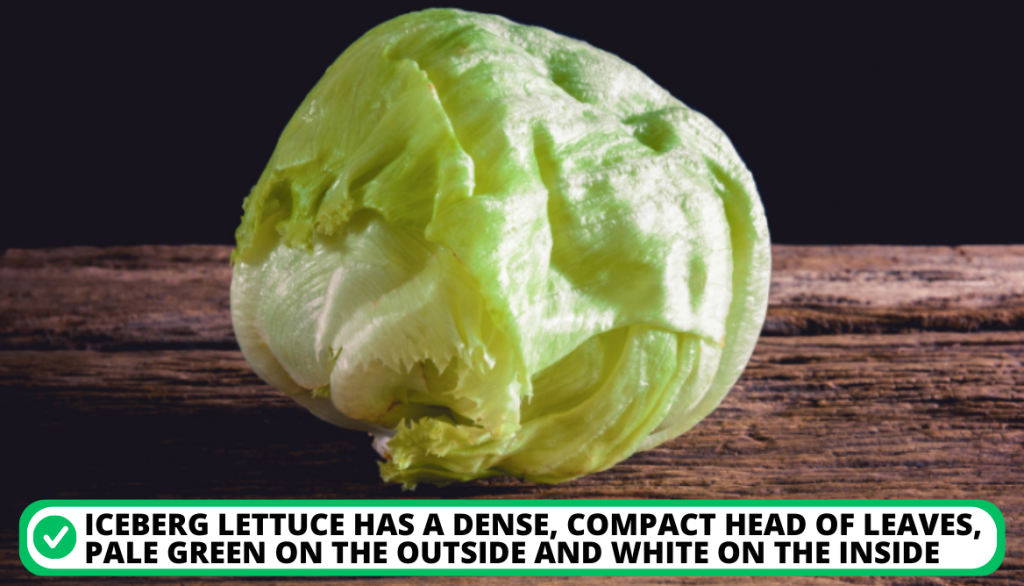
Butterhead Lettuce
This type of lettuce has loose heads of leaves that are soft, tender, green on the outside, and lighter green or yellow on the inside. Learn more.
- Taste: Soft and buttery
- Texture: Little crunch
- Nutrients: Vitamin A, Vitamin K, and Folate.
- Climate: Thrives in cooler climates
- Harvesting: Cut a whole head or Cut leaves slightly to be replaced.
- Aquaponic Systems: Best for Nutrient Film Technique. (Can grow in others)
- Difficulty: Easily grown vegetables and maintain.
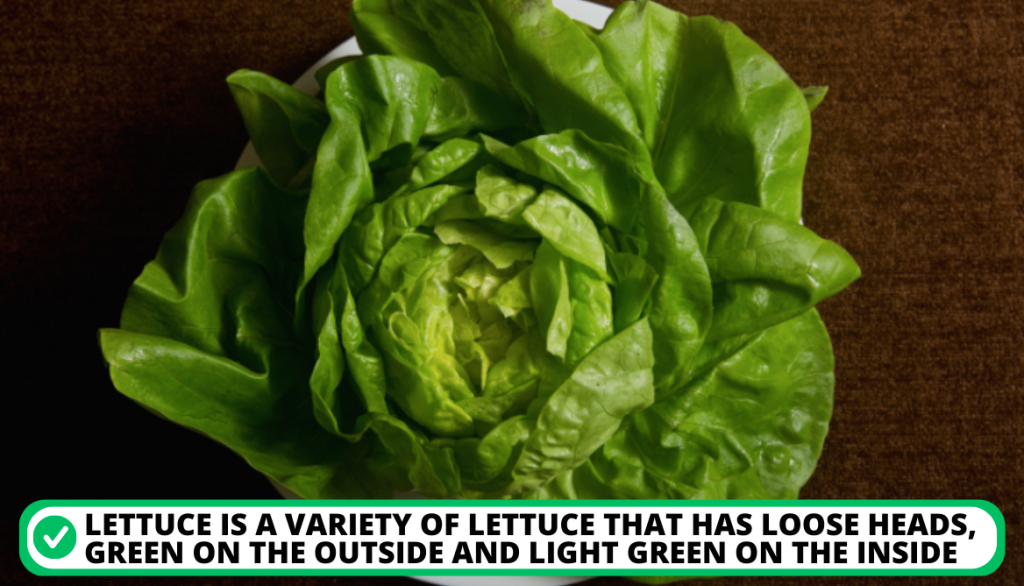
Romaine Lettuce
This type of lettuce has elongated heads of leaves that are green on the outside and lighter green or white on the inside. Look at its other amazing qualities:
- Taste: Slightly bitter, nutty flavor
- Climate: Better in cooler climates. Can survive some heat before bolting
- Texture: Crunchy but less than iceberg
- Nutrients: Vitamin A, Vitamin K, and folate
- Harvesting: Slice a piece or harvest from the head.
- Aquaponics System: Any system will grow romaine effectively.
- Difficulty: Does not need much effort to grow but it takes time.
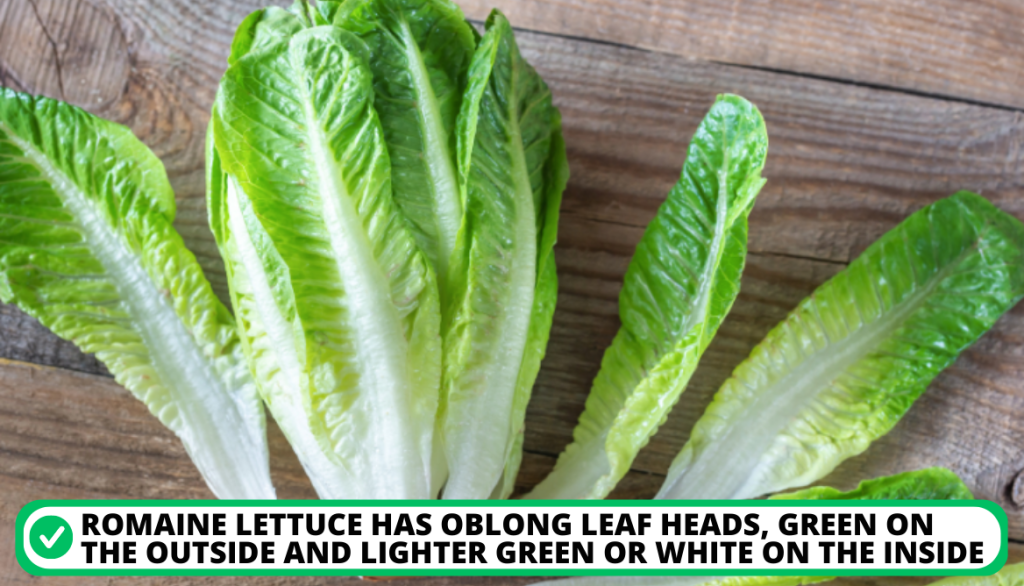
Loose Leaf Lettuce
Loose leaf lettuce as indicated by its name is a type of lettuce that grows in loose bunches or leaves, rather than forming a tight head. What else is special about it? Read below
- Taste: Mild and sweet flavor
- Texture: Soft and tender
- Nutrients: Vitamins A and K, as well as folate
- Climate: Keep in cooler climates
- Harvesting: Cut from its leaves
- Aquaponics System: Deep water culture, Media bed or any system will work
- Difficulty: Very easy to grow.
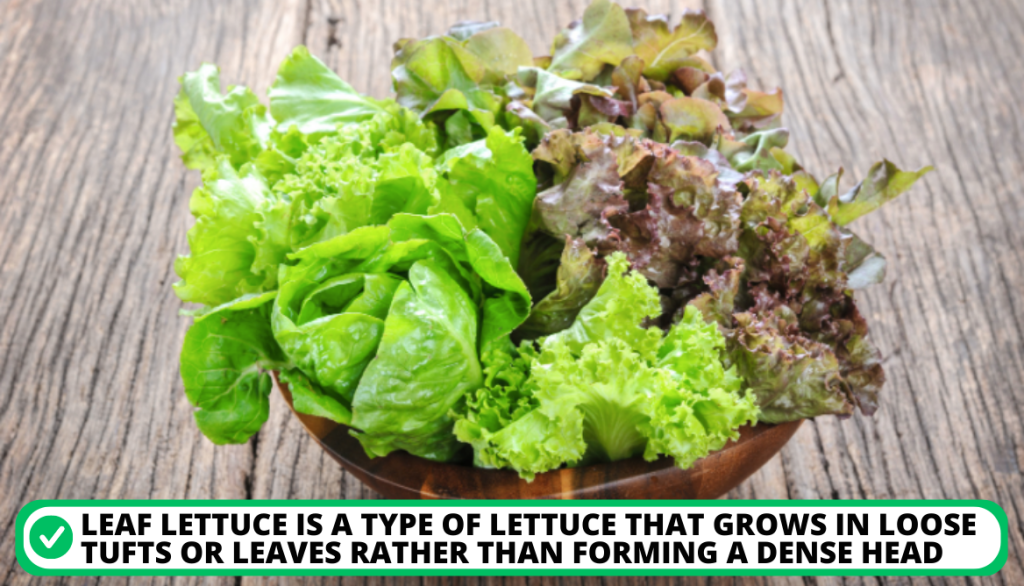
FAQ
How long does it take to grow lettuce in aquaponics?
It takes 30 days long to grow lettuce in aquaponics for most varieties. Types like Tom Thumb butterhead lettuce, Frisee endive lettuce, and Celtuce lettuce can take 1.5 to 2.5 months.
How do you start lettuce in aquaponics?
You start lettuce in aquaponics by germination of seeds. Use a starter kit, foam sponges, or paper towels to turn them into seedlings then transplant them into the system.
What pH should lettuce be for aquaponics?
pH should be 5.5 to 6.0 for lettuce aquaponics. It can still survive outside this range, though it may not taste the best.
What pH should lettuce be for aquaponics?
pH should be 5.5 to 6.0 for lettuce aquaponics. It can still survive outside this range, though it may not taste the best.
How long does lettuce take to grow?
Lettuce takes 30 to 70 days to grow. The leafy ones reach maturity early but the dense head takes a longer time.
What type of lettuce is best for aquaponics?
The type of lettuce that is best for aquaponics is Loose leaf as it grows easily and quite quickly making it great for beginners. The skilled ones should grow romaine and iceberg too.
Conclusion
We were able to learn that lettuce compared to other plants is perfect for growing in aquaponics systems. It grows in a month and is full of healthy elements due to aquaponic fish and nutrient-rich solution.
There is less risk of pests and the need for maintenance and watering. To get the best harvest to grow these in a cooler climate, with pH levels of 5.5 to 6.0, place them 7 inches apart and give lots of sunlight.
Are you planning on starting your aquaponics garden by growing lettuce then? Which variety will you plant?
- How to Get Potatoes to Sprout Eyes: Detailed Growing Guide with 3 Options - July 31, 2023
- Weight of a Medium Potato: Revealed in Detailed Guide - July 29, 2023
- Maris Piper Potatoes: 9 Substitutes You Should Know About - July 27, 2023
Hello! I’m Jessica Zander, a garden coach and consultant based in the Boston area (zone 6b), offering virtual consultations across the country and Canada.
I’ve been passionate about gardening since the early 1990s, and in 2022, I launched You Can Do It Gardening to empower individuals to feel more confident in their gardening endeavors.
Following a 30-year career in nonprofit finance and operations, I transitioned out of that field in mid-June of 2023 due to the growing demand for coaching services. Interestingly, my years of presenting financial statements to boards and finance committees proved to be valuable experience for teaching people about gardening! I enjoy sharing skills, providing guidance and suggestions, and collaborating efficiently with clients to make significant improvements to their outdoor spaces, both small and large. I also regularly teach at the Arlington Continuing Education and Cambridge Adult Education.
My approach is direct and practical, akin to Mary Poppins, but tailored to your garden. Clients find satisfaction in saving money and taking pride in their own gardening achievements.

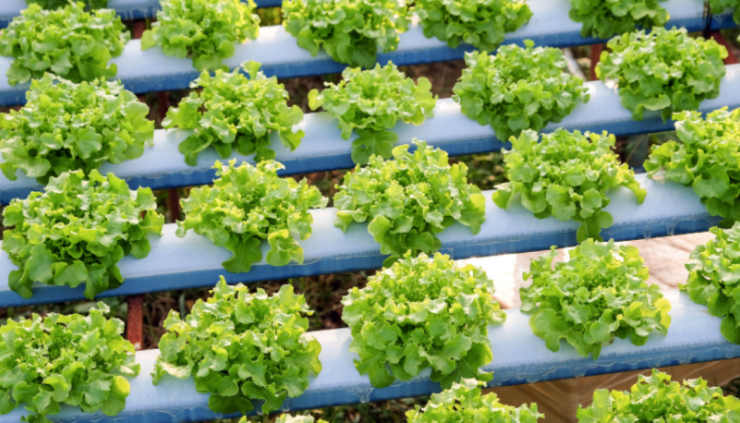
Add comment